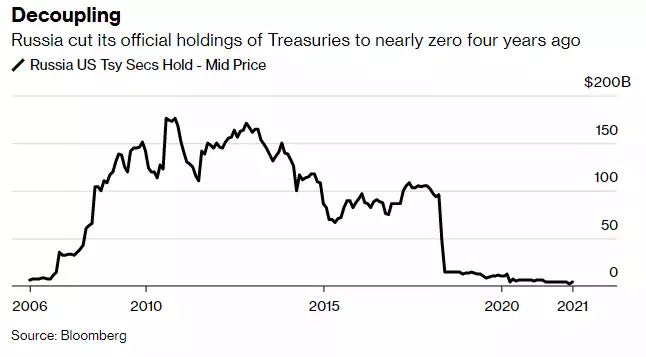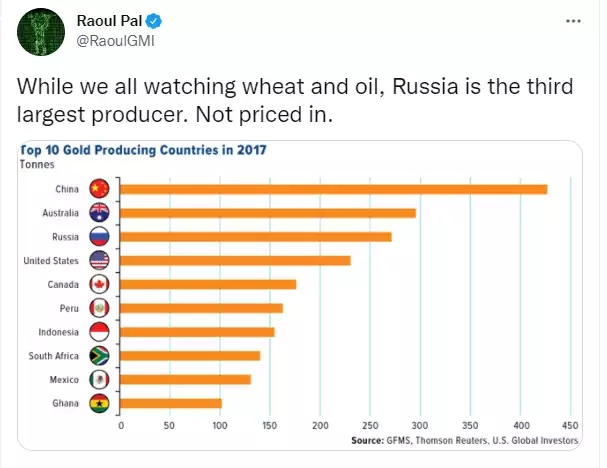Gold & Financial Sanctions Warfare
News
|
Posted 04/03/2022
|
11225
Yesterday we talked of bank runs from Russian banks and the concept of “inside money” at the individual level and touched on the sovereign level too. At what is potentially another critical turning point in the global reserve currency history, today we will delve deeper at the sovereign level as it ultimately affects us all at the individual level depending on whether we hold our wealth as “outside money”.
In that same interview with Bloomberg Credit Suisse’s Zoltan Pozsar goes on to explain the “inside money” v “outside money” analogy we discussed yesterday as it pertains to Foreign Exchange reserves held by sovereign nations.
““Most FX reserves that exist in the world today are all forms of inside money, i.e. they are the liabilities of someone,” Pozsar said on Odd Lots. “Whether you hold the sovereign debt of a country, or you keep a deposit at a central bank of a foreign country, or if you keep deposits at Western financial institutions, these are all forms of inside money that you don't control. Someone owes it to you. And these things can be sanctioned.”
“If a central bank is in a situation like this and the currency’s under pressure, would it ever come to having to re-anchor your currency to something? Like gold? I think these are all questions that should be top of mind,” he added. “I don't know if it'll come to that, but if things get worse, you could basically re-anchor the ruble to a pile of gold because you need an anchor in situations like this.”
Pozsar’s not alone in his warnings about the dollar's vulnerability, with others seeing the same forces at play in the fate of the currency’s reserve status. Dylan Grice, the former Societe Generale strategist who’s since founded Calderwood Capital, described the recent moves as a “weaponization” of money. “You only get to play the card once,” he tweeted. “China will make it a priority to need no USD before going for Taiwan. It’s a turning point in monetary history.””
The chart below may tell you when Putin started to prepare for the Ukraine invasion and the inevitable weaponisation of the USD..

As we have reported many times over this period, this de-dollarisation has seen Russia amass a pile of gold holdings to be the 5th largest in the world. People often forget too that Russia tussles with Australia over the 2nd biggest producer of gold in the world behind China. Macro Insider’s Raoul Pal tweeted yesterday to that effect.. (albeit with an old chart)

As Pal states, whilst gold has risen during the conflict, its arguably not pricing in the impact of Russian supply being removed from the market through sanctions. Nor arguably is it pricing in the demand from central banks buying more of it as this “inside money” trap becomes more obvious to those states exposed.
Curiously that same Bloomberg article states:
“There’s another problem facing countries with large amounts of reserves that no longer want to hold them in dollar-denominated assets: They’ll need to find something else to buy, and the pool of potential suitable assets could be limited. While gold is the obvious candidate, there’s only so much of it available”
This clearly misses the point of where gold presents the solution. It doesn’t matter how little of it there is. That indeed is the value proposition. If there is more demand for something with fixed and rare supply, that importantly is as divisible as gold is, then the price just goes up. They need to secure value not troy ounces.
The scale of what we are discussing is huge. Last year central bank foreign currency reserves totalled a record $12.83 trillion and have risen $11 trillion just over the past 20 years. Currently most is held in U.S. and European government bonds, with the U.S. dollar still accounting for almost 60% of that and the Euro about 20%.
The single biggest holder of this “inside money” is China which holds over $3.2 trillion. This of course is a double edged sword in terms of financial warfare. Should the US financially sanction China upon a Taiwan invasion, China could dump those treasuries so quickly as to kill the USD. Whilst that of course would also hurt China, they have, since 2013 been the biggest accumulators of gold every single year and at an incredible pace. Again, per the chart above, they are also the biggest producer. To kill the USD would see gold skyrocket and potentially present a zero sum game for China, but a fatal one for the US. As with anything geopolitical and FX related its never that simple but broadly you can see the picture. Sovereign bonds are spoken of in the same ‘safe haven’ asset class as gold. Bonds are debt instruments in a world of unprecedented and unsustainable debt and have been as weaponised as the USD.
In this web of inextricably interrelated, counterparty risk strewn, global, macro and micro financial assets, precious metals sit apart as the very few hard assets with ZERO counterparty risk. They are no one’s liability. That is as relevant to you the individual as it is to banks and global leaders.